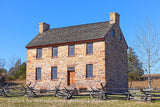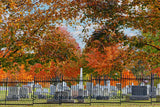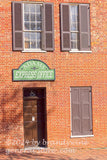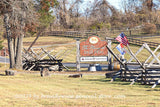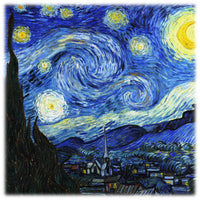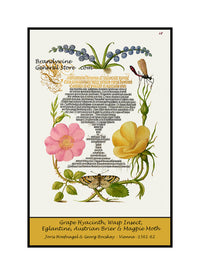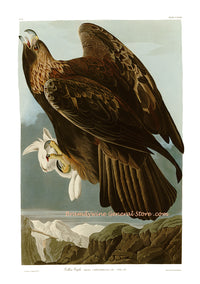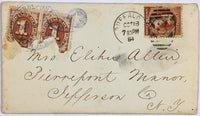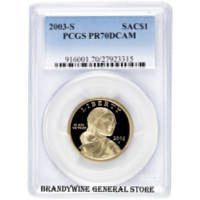Rusty Grakle or Crow by John James Audubon
An archival premium Quality art Print of The Rusty Grakle or Rusty Crow Blackbird by John James Audubon for sale by Brandywine General Store. This bird painting was picture or plate number 157 in the great ornithology book by Audubon entitled The Birds of America. These plates are taken from the first Havell edition. The picture shows four specimens of these blackbirds with a male, female and two young birds, all are setting in a Black Haw Tree. The female is at the bottom, the male in the center with a ripe berry or fruit from this tree in his mouth, while the two young are in the top branches. All are getting ready to make a meal on these ripe fruits. This must be late in the season because the leaves have lost most of their color and are a dull yellow and brown color, while the birds are black and brown in color. So not many bright colors in this Audubon print, but painted realistically to match the scene from which he painted.. Mr. Audubon describes the Rusty Grakle or Crow Blackbird in Birds of America thus "In the winter months the Rusty Grakle is found as far south as Lower Louisiana and the Floridas, which it reaches in small flocks, along with the Cow Bunting and Red-winged Starling, with which it continues frequently to associate until the return of spring. At this season it occurs in all the Southern and Western States, as well as in the Middle and Eastern Districts., where some remain during the most severe cold. These Grakles are fond of the company of cattle, and are seen with them in the pastures or in the farm-yards, searching for food among their droppings, and picking up a few grains of the refuse corn. They are less shy than the other species, possibly because less acquainted with man, as they retire to the north for the purpose of breeding. In the winter they frequently resort to moist places, such as are met with round the ponds and low swampy meadows, where you sometimes find a single one remaining for weeks apart from its companions. They then feed on aquatic insects and small snails, for which they search diligently among the rank reeds or sedges, which they climb with great agility. Their note is a kind of chuck. It is rare to meet with them in full plumage at this time, even the old males becoming rather rusty, instead of being of a pure glossy black, as they are in spring. About the beginning of March, the males are seen moving northwards. They cross the greater part of the United States almost in silence and unheeded, seldom tarrying any where until they reach the State of Maine, where some few remain to breed, while the greater number advance farther north. I saw some of these birds on the Magdeleine Islands, in Newfoundland, as well as in Labrador, where many breed. Their migrations are performed by day. In their habits they resemble the Red-winged Starling, becoming loquacious at this season, and having a lively and agreeable song, although less powerful in tone than that of the species just mentioned. Equally fond of the vicinity of meadows or moist places, they construct their nests in the low bushes that occur there. The nest is not so large as that of the Redwing, but is composed of much the same materials. In Labrador I found it lined with moss instead of coarse grass. The eggs are four or five, of a light blue colour, streaked and dashed with straggling lines of brown and deep black, much smaller than those of the Redwing, but in other respects bearing a considerable resemblance to them. They begin to lay about the 1st of June, in the State of Maine, and fully a fortnight later in Labrador. They raise only one brood in the season. The young, when first able to fly, are nearly of a uniform brown, brighter on the breast and shoulders. Although they seem to prefer alder and willow bushes, for the purpose of incubation, I have found their nests among the tall reeds of the Cat's-tail or Typha, to which they were attached by interweaving the leaves of the plant with the grasses and strips of bark of which they were externally composed. During early autumn, and before they remove southward, they frequently resort to the sandy beaches of lakes, rivers, and the sea, in search of small testaceous mollusca and aquatic insects. They do little or no mischief in the corn-fields. While walking they frequently jerk their tail, and move with much grace, in the same manner as other birds of the genus. Their flight resembles that of the Red-winged species. An acquaintance of mine, residing in New Orleans, found one of these birds, a beautiful male in full plumage, not far from that city, while on one of his accustomed walks. It had been shot, but was only slightly injured in one of its wings, and as it was full of vivacity, and had a clear and brilliant eye, indicating that its health had not suffered, he took it home and put it in a cage with several Painted Buntings. They soon became accustomed to each other, the Grakle evincing no desire to molest its smaller companions. I saw it when it had already been caged upwards of four months, and had the satisfaction to hear it sing repeatedly. Its notes, however, were less sonorous than they usually are when the birds are at liberty. It frequently uttered its travelling chuck-note. It was fed entirely on rice. This was the only specimen I ever saw in captivity, and it proved a very amiable companion. I have figured three of these birds, to enable you the better to understand their different states of plumage, and placed them on a plant of the genus Prunus, which grows in Louisiana, and on the berries of which they occasionally feed...." Audubon Birds art print #157



